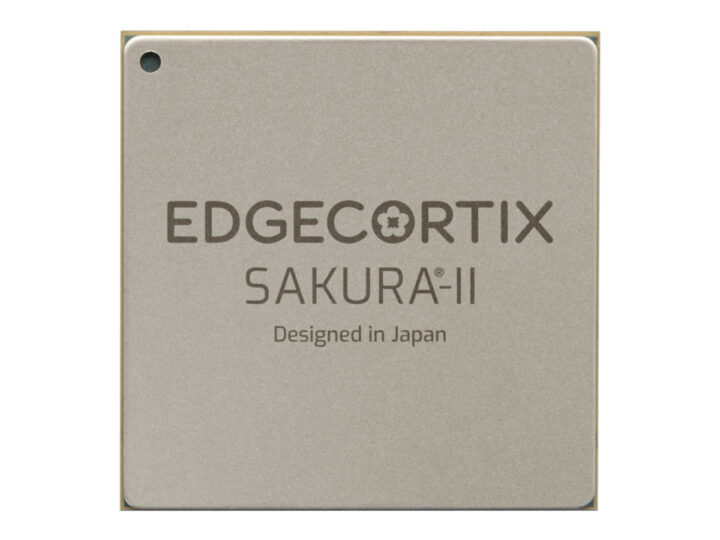EdgeCortix has just announced its SAKURA-II Edge AI accelerator with its second-generation Dynamic Neural Accelerator (DNA) architecture delivering up to 60 TOPS (INT8) in an 8Watts power envelope and suitable to run complex generative AI tasks such as Large Language Models (LLMs), Large Vision Models (LVMs), and multi-modal transformer-based applications at the edge.
Besides the AI accelerator itself, the company designed a range of M.2 modules and PCIe cards with one or two SAKURA-II chips delivering up to 120 TOPS with INT8, 60 TFLOPS with BF16 to enable generative AI in legacy hardware with a spare M.2 2280 socket or PCIe x8/x16 slot.
SAKURA-II Edge AI accelerator
SAKURA-II key specifications:
- Neural Processing Engine – DNA-II second-generation Dynamic Neural Accelerator (DNA) architecture
- Performance
- 60 TOPS (INT8)
- 30 TFLOPS (BF16)
- DRAM – Dual 64-bit LPDDR4x (8GB,16GB, or 32GB on board)
- DRAM Bandwidth – 68 GB/sec
- On-chip SRAM – 20MB
- Compute Efficiency – Up to 90% utilization
- Power Consumption – 8W (typical)
- Package – 19mm x 19mm BGA
- Temperature Range – -40°C to 85°C

The SAKURA-II platform is programmable with the MERA software suite featuring a heterogeneous compiler platform, advanced quantization, and model calibration capabilities. The software suite natively supports development frameworks such as PyTorch, TensorFlow Lite, and ONNX. It also integrates with the MERA Model Library, interfacing with Hugging Face Optimum, to offer a large range of the latest transformer models such as Llama-2 or Stable Diffusion, and convolutional models such as Yolo V8.


SAKURA-II M.2 and PCIe accelerators
EdgeCortix can provide the SAKURA-II as a standalone device as described above, but the company has also been working on two M.2 modules with a single chip and 8GB or 16GB DRAM capacity, and single and dual-device low-profile PCIe cards.

M.2 SAKURA-II modules’ key features:
- DRAM
- 8GB (2x banks of 4GB LPDDR4) OR
- 16GB (2x banks of 8GB LPDDR4)
- Host Interface – PCIe Gen 3.0 x4
- Peak Performance – 60 TOPS with INT8, 30 TFLOPS with BF16
- Module Power – 10W (typical)
- Dimensions – M.2 Key M 2280 module (22mm x 80mm)
Both the 8GB and 16GB models have the same performance and typical power consumption, so selecting one over the other is just a case of finding out whether the model will fits into 8GB of RAM, or requires more.
PCIe cards’ specifications:
- Host Interface – PCIe Gen 3.0 x8
- Single-chip model
- DRAM Memory – 16GB (2x banks of 8GB LPDDR4)
- Peak Performance – 60 TOPS with INT8, 30 TFLOPS with BF16
- Card Power – 10W (typical)
- Dual-chip model
- DRAM Memory – 32GB (2x banks of 16GB LPDDR4)
- Peak Performance – 120 TOPS with INT8, 60 TFLOPS with BF16
- Card Power – 20W (typical)
- Form Factor – PCIe low profile, single slot
- Included accessories – Half-height and full-height brackets and active or passive heat sink
EdgeCortix is taking pre-orders for the M.2 modules and PCIe cards for delivery in H2 2024 with the following pricing:
- M.2 8GB – $249
- M.2 16GB – $299
- PCIe single – $429
- PCIe dual – $749
We are seeing more and more M.2 and PCIe Edge AI accelerators with the most popular (based on news coverages) being the Google Coral Edge TPU, Intel Myriad X, and Hailo-8 modules. There are others such as the Axelera AI module that’s the most impressive on paper, but it’s always difficult to compare different accelerators due to the lack of a standardized benchmark.
With silicon vendors now integrating powerful AI accelerators into SoCs including the new ones from Intel and AMD, it’s unclear whether this type of AI accelerators will have a long life in front of them, except if they can be combined with low-end processors. Only time will tell.
You’ll find more details about the SAKURA-II chip and module on the product page and in the press release.

Jean-Luc started CNX Software in 2010 as a part-time endeavor, before quitting his job as a software engineering manager, and starting to write daily news, and reviews full time later in 2011.
Support CNX Software! Donate via cryptocurrencies, become a Patron on Patreon, or purchase goods on Amazon or Aliexpress





